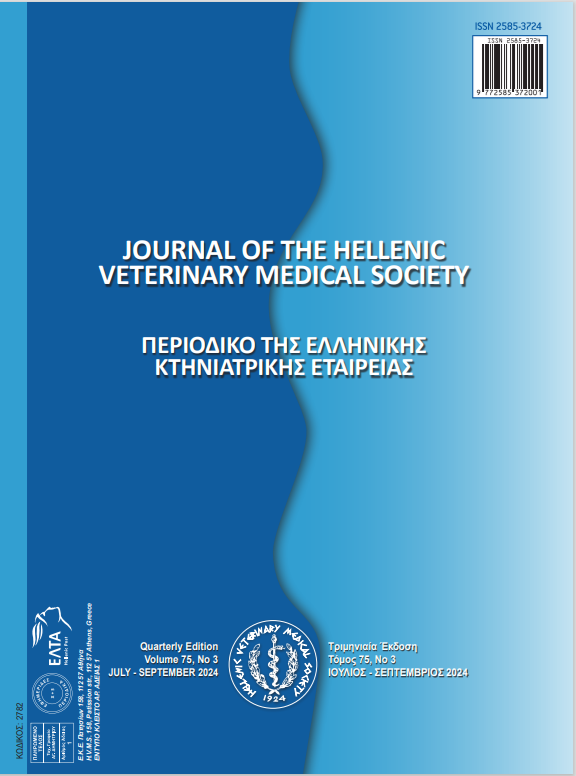Occurrence of canine and human leishmaniosis between 2020 and 2022 in the Alto Tâmega region (Portugal): a descriptive study of seropositivity in clinically suspected dogs, a status report on the occurrence of cases in humans and perception of the disease by pet tutors
Περίληψη
Zoonotic visceral leishmaniosis is a severe neglected zoonotic parasitic disease caused by Leishmania infantum with dogs as the major reservoir hosts. Although the European Centre for Disease Prevention and Control (ECDC) reported, in 2022, no human or animal cases in the Alto Tâmega region between 2009-2020, the truth is that there were notified cases. The present study main objective was to determine the occurrence of infection and disease among 217 clinically suspected dogs subjected to serological tests in a Reference Veterinary Clinic in the Alto Tâmega region and among human patients of the Public Health Unit of Alto Tâmega e Barroso actuation area, in northern Portugal. In addition, a questionnaire was presented to 100 of the clinic's clients during the last fortnight of October 2022. The majority of sampled dogs had no defined breed (43.7%), they were mainly males (56.7%) and under 10 years of age (29.5%). Between January 2020 and September 2022, there were 64 seropositive dogs among those subjected to anti-Leishmania antibody detection, indicating that canine leishmaniosis (CanL) had 29.5% of occurrence within the sample of the population studied. Among the seropositive dogs, 44.4% were mongrel dogs and 56.52% were males. There were no reported human cases between 2020 and 2022. The majority of the questionnaire respondents believed that leishmaniosis does not affect humans (39.0%) and that is not a public health issue (33.0%) and a
considerable part of the sample does not have a position about those questions (33.0% and 42.0%, respectively). Based on the survey sample collected, most people may not associate the disease with a zoonosis and, therefore, there may be a risk of underdiagnosis and underreport, as there is no demand for treatment and medical diagnosis directed towards some suspected cases or because human cutaneous leishmaniosis is not a notifiable disease. An improvement in education of the population in areas of endemicity is needed to reach the objective of minimizing the impact of leishmaniosis, perform a proper diagnosis and treatment, and ensure a safer bond between animals and humans.
Λεπτομέρειες άρθρου
- Πώς να δημιουργήσετε Αναφορές
-
Rodrigues, M., Cardoso, L., & Costa, J. (2024). Occurrence of canine and human leishmaniosis between 2020 and 2022 in the Alto Tâmega region (Portugal): a descriptive study of seropositivity in clinically suspected dogs, a status report on the occurrence of cases in humans and perception of the disease by pet tutors. Περιοδικό της Ελληνικής Κτηνιατρικής Εταιρείας, 75(3), 7641–7648. https://doi.org/10.12681/jhvms.32080
- Τεύχος
- Τόμ. 75 Αρ. 3 (2024)
- Ενότητα
- Research Articles

Αυτή η εργασία είναι αδειοδοτημένη υπό το CC Αναφορά Δημιουργού – Μη Εμπορική Χρήση 4.0.
Οι συγγραφείς των άρθρων που δημοσιεύονται στο περιοδικό διατηρούν τα δικαιώματα πνευματικής ιδιοκτησίας επί των άρθρων τους, δίνοντας στο περιοδικό το δικαίωμα της πρώτης δημοσίευσης.
Άρθρα που δημοσιεύονται στο περιοδικό διατίθενται με άδεια Creative Commons 4.0 Non Commercial και σύμφωνα με την άδεια μπορούν να χρησιμοποιούνται ελεύθερα, με αναφορά στο/στη συγγραφέα και στην πρώτη δημοσίευση για μη κερδοσκοπικούς σκοπούς.
Οι συγγραφείς μπορούν να καταθέσουν το άρθρο σε ιδρυματικό ή άλλο αποθετήριο ή/και να το δημοσιεύσουν σε άλλη έκδοση, με υποχρεωτική την αναφορά πρώτης δημοσίευσης στο J Hellenic Vet Med Soc
Οι συγγραφείς ενθαρρύνονται να καταθέσουν σε αποθετήριο ή να δημοσιεύσουν την εργασία τους στο διαδίκτυο πριν ή κατά τη διαδικασία υποβολής και αξιολόγησής της.




